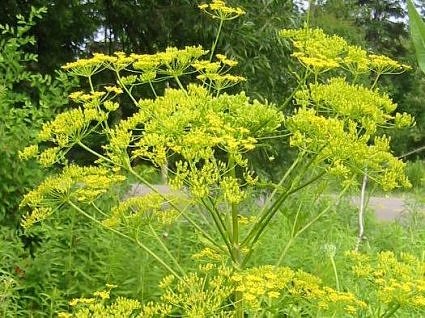Watch out for wild parsnip
This flowering weed may look pretty, but it bites.

© Beth Gauper
In the good old days, the only plant people had to watch out for was poison ivy.
Now, there's wild parsnip, the evil sister of Queen Anne's lace. A native of Europe and Asia, it has spread like wildfire across the Upper Midwest, and fire is what it feels like on exposed skin.
"Most people get a nasty, nasty rash from it," says Karla Bloem, naturalist and director of the International Owl Center in southeast Minnesota. "It's not like nettles or poison ivy; this is like a chemical burn. If you get it bad enough, it can scar you for life."
It's actually a sunburn, caused by plant chemicals that, when energized by ultraviolet light, destroy cells and skin tissue. In mild cases, the skin simply reddens.
But if skin has been extensively exposed to the plant and then to sunlight, it may blister, leaving a purplish discoloration that may last a long time.
"We've heard about people who get it one year and get over it, and then it comes back the next year," Bloem says.
Wild parsnip arrived first in southern Wisconsin and now has been reported throughout the state. Specialists for the Wisconsin DNR suspect it's everywhere.
"What we've been hearing from other states is that it's pretty well sped across the state in a few years, and that's what we're seeing here," said Kelly Kearns, DNR plant conservation program manager.
When wild parsnip arrived in southeast Minnesota, it was noticed first by people who work alongside highways, trails or rivers. The plant likes to settle in disturbed areas, such as ditches, prairie restorations, canoe takeouts and trail or stream easements.
Shawn Fritcher, resource manager for southeast Minnesota state parks, said he got burned while wearing short sleeves when working amid wild parsnip.
"I had big blisters, and they lasted quite a while," he said. "It was fairly painful; a real nuisance, that's for sure. And the case I had was mild compared with other people."
His crews try to control it by mowing the plants down in early June, just after they flower but before they go to seed.
"Nothing has been super successful," Fritcher says.
Wild parsnip also is common in Iowa and Illinois, and it's spreading to northern Minnesota and northern Michigan.
In June and throughout the summer, hikers, bicyclists and canoeists should be on the lookout for it.
All parts of the plant are noxious, but the seed heads seem to cause a greater burn, Kearns says. The plant is thigh-high or taller and looks much like Queen Anne's lace — but the lacy flowers are yellowish-green, not white.
The best thing to do is stay away from it. If you have to pull it up, however, wear protective clothing, including long sleeves and gloves, and try to work after dark; better yet, Skinner says, cut the roots below ground with a sharp shovel.
Whatever you do, don't use a weed whacker after the flowers have produced seeds, or you'll sprinkle wild parsnips all over your neighborhood.
In Wisconsin, Kearns says the state never will able to control wild parsnip.
"We're way beyond that," she said. "It's so widespread, we don't expect any kind of widespread eradication."
Giant hogweed is another matter. A tree-sized cousin of wild parsnip and Queen Anne's lace, it has been spotted in the Hurley-Ironwood area, and Kearns fervently hopes it will stop there.
"This is one (time) we're on more of a red alert," she says. "If you find it, let us know immediately, so we can eradicate it."
Giant hogweed is just as nasty as wild parsnip, but, unfortunately, more attractive to gardeners, who, Kearns suspects, brought it to Wisconsin.
"It's got huge, very showy white flowers; you can see why people would be interested in it," she says. "And who would suspect that the rash on you is from one of these plants you touched three days ago? Because it takes a while to get it."
For help identifying wild parsnip, take a look at this photo gallery from the Wisconsin DNR. The Minnesota DNR also has a page with photos and information.